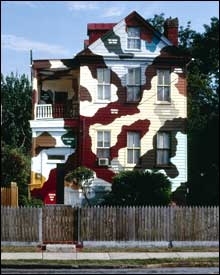 Groundbreaking takes on new meaning when it’s applied to the work of Kate Ericson and Mel Ziegler, the subjects of an important new show at MIT’s List Center. In the course of their career they busted sidewalks, lifted stones from Mount Rushmore, suspended the lawn of a Los Angeles home onto a scaffold, and extended a stone wall into the living space of a residence in suburban Houston. They met as undergraduates. Ericson was studying painting at the Kansas City Art Institute; Ziegler was a sculpture student at the Rhode Island School of Design — until he transferred to Kansas City in 1977. Beginning with their thesis show, which paired Ericson’s coal chutes with Ziegler’s corrugated aluminum walls (Coal Chutes and Wall Piece, 1978), the two embarked on collaborative career hopscotching the United States. (Ericson died of cancer in 1995, age 39.) They created 19 large-scale public works, numerous museum and gallery projects, and an untold number of independent objects. So why have so few heard of this couple who made monumental imprints on such cities as Washington, Seattle, Chicago, and Philadelphia?
Groundbreaking takes on new meaning when it’s applied to the work of Kate Ericson and Mel Ziegler, the subjects of an important new show at MIT’s List Center. In the course of their career they busted sidewalks, lifted stones from Mount Rushmore, suspended the lawn of a Los Angeles home onto a scaffold, and extended a stone wall into the living space of a residence in suburban Houston. They met as undergraduates. Ericson was studying painting at the Kansas City Art Institute; Ziegler was a sculpture student at the Rhode Island School of Design — until he transferred to Kansas City in 1977. Beginning with their thesis show, which paired Ericson’s coal chutes with Ziegler’s corrugated aluminum walls (Coal Chutes and Wall Piece, 1978), the two embarked on collaborative career hopscotching the United States. (Ericson died of cancer in 1995, age 39.) They created 19 large-scale public works, numerous museum and gallery projects, and an untold number of independent objects. So why have so few heard of this couple who made monumental imprints on such cities as Washington, Seattle, Chicago, and Philadelphia?
Part of the answer lies in their self-effacing, egalitarian æsthetic. The two were committed to public art projects that materially benefitted communities or individuals, projects that once completed were frequently intended to disappear. Loaded Text stirred controversy and Durham, North Carolina, in the summer of 1989, when the artists capitalized on the confluence of the issuing of the Downtown Durham Revitalization Plan and a four-day public-art conference. Having learned that only two copies of the plan were available to the public, the couple decided to write out the entire 65-page text on a spread of badly broken sidewalk outside the Durham post office. After a few days, and at their own expense, they hired a contractor to remove the dilapidated, inscribed sidewalk (which filled four dumptrucks that were parked in front of the Durham Arts Council for the duration of the public-art conference) and replace it with new cement. To complete the project, the dumptrucks deposited their debris by a nearby stream, where the artists used it to shore up eroding banks. In an interview in this show’s lucid and illuminating catalogue, Ziegler says, “It disappeared in an interesting way — we got to do an artwork, the people got a new sidewalk, there was a place where the erosion was being stopped because of the rubble; there were no loose ends.” Imagine: art meets public policy meets urban renewal meets conservation.
Many Ericson-Ziegler collaborations disappeared in interesting ways. House Monument (1986) comprised more than 1300 pieces of plywood and two-by-fours — enough to build an actual house — that were inscribed with language that reflected on the meaning of house and home. (One sheet quoted Nathaniel Hawthorne: “What we call real estate — the solid ground to build a house on — is the broad foundation on which nearly all the guilt of the world rests.”) After being exhibited at the Los Angeles Institute of Contemporary Art, the lumber was sold at half price to a family in Costa Mesa, California, to build a new home. The one stipulation: none of the language on any of the wood was to be visible. In College Ivy, the construction cost of every building at San Diego State University was displayed in large, white numerals in front of each building, as if the entire campus were on the auction block for a brief period in 1989.